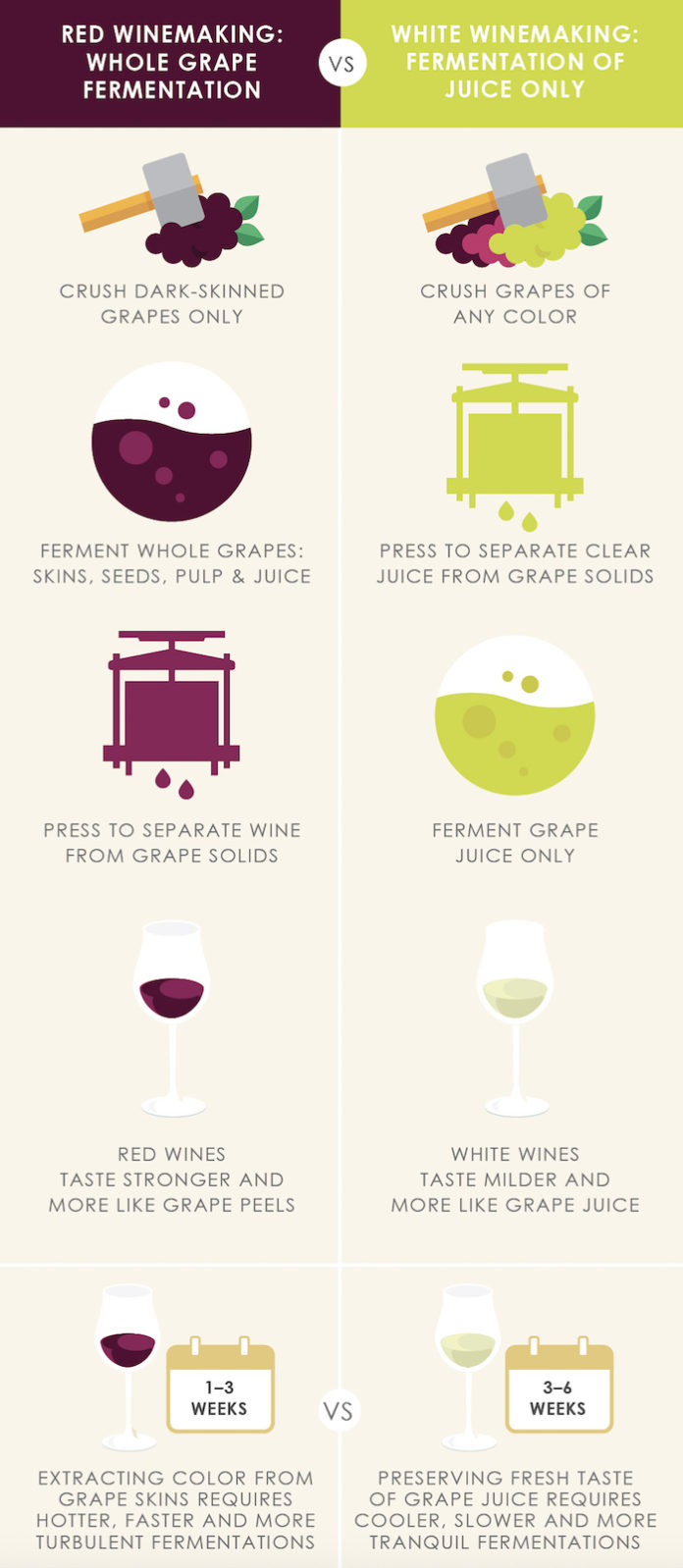In wine grapes, color resides ONLY in the skins; the pulp and juice are translucent when we cut grapes open, regard-less of skin color. This explains why grapes of any color can be made into a “colorless” white wine, but only grapes with deeply-tinted skins can be used to make a wine dark enough to be called a red wine. In fact, the main differences between red and white wines do not derive as much from the type of grapes used as they do from the different processes by which we ferment the two styles.
White wines are made without grape skins – the grape solids are discarded immediately and only the clear juice is fermented. This explains how it’s possible to make white wines out of grapes that aren’t green, as with Champagne or pinot grigio. Red wines are fermented with their skins, and it is the color, flavor and tannin compounds found in those skins that give red wines their color and their unique taste. As a result, reds feature the stronger, more bitter flavor of grape peels, while white wines have the milder flavor of peeled grapes or white grape juice.
Picture following two recipes that use the same ingredients – one hot and one cold. Peeling and straining fresh tomatoes and chilling them overnight with onions and peppers creates a delicate gazpacho soup that preserves the gar-den-fresh taste of the ingredients. Crushing and simmering those same tomatoes whole with onions and peppers will produce a thicker, stronger-tasting pasta sauce whose tomato taste is deepened and enriched by the cooking process.
Winemakers get similar results with grapes. Making white wine involves not only removing grape skins but also fermenting in a closed vessel at colder temperatures in order to retain fresh-picked grape flavor. Making red wine requires the opposite: maximizing grape skin contact during fermentation in open containers at warmer temperatures to extract as much of their color and flavor as possible. Since color compounds contain harsh tannins that act as natural preservatives, but require some maturation to soften, this helps explain why red wines are more often aged in barrels after fermentation than whites as well.
Formerly the director of wine studies for Manhattan’s French Culinary Institute, Marnie Old is best known for her books published by DK – the award-winning Wine: A Tasting Course and He Said Beer, She Said Wine. Read her piece How to Judge Wine Styles By Their ABV.





[…] Formerly the director of wine studies for Manhattan’s French Culinary Institute, Marnie Old is best known for her books published by DK – the award-winning Wine: A Tasting Course and He Said Beer, She Said Wine. Read her piece The Real Difference Between Red and White Wine. […]
[…] Formerly the director of wine studies for Manhattan’s French Culinary Institute, Marnie Old is best known for her books published by DK – the award-winning Wine: A Tasting Course and He Said Beer, She Said Wine. Read her piece The Real Difference Between Red and White Wine. […]
[…] Formerly the director of wine studies for Manhattan’s French Culinary Institute, Marnie Old is best known for her books published by DK: the award-winning Wine: A Tasting Course and He Said Beer, She Said Wine. Read her piece The Real Difference Between Red and White Wine. […]
You are so right about the flavour of white wine is milder. It tasted good when we tried.